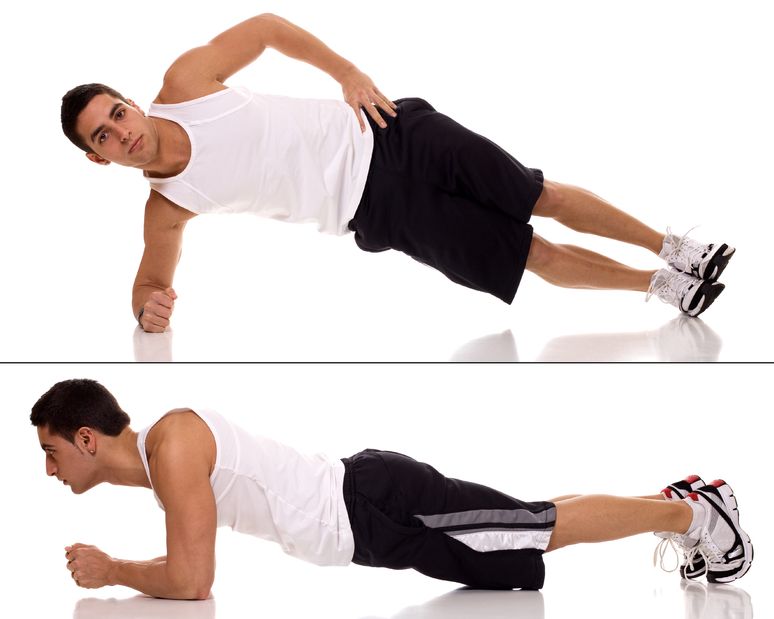Core Conditioning without Sit-Ups

Tips For Abdominal Exercises
- Ask your Physical Therapist for abdominal strengthening exercises that do not include repetitive lumbar flexion.
- Perform core exercises in many planes of motion to simulate functional motions.
- Theraball roll outs and prone planks with your heels/ankles on the ball are great core exercises.
- Add rotational exercises on the ball to engage all of the abdominal muscles.
- If you are going to compete in a high level athletic competition, standard sit-ups might be a small part of your abdominal work out.
Sit-Ups May Cause Back Pain
From developing flat, tight abs to fighting low back pain, sit-ups seem like the ideal exercise. In fact, healthcare professionals have prescribed sit-ups for many years as a way to prevent low back pain, but that is changing.
While there is general agreement that a strong, well-conditioned core will help to prevent low back pain, sit-ups are no longer considered the optimum exercise for conditioning the core. The repeated action in common sit-ups could damage parts of the spine and lead to low back pain. Physical Therapists now direct patients to alternate exercises that strengthen the abdominal muscles and deliver core-conditioning benefits without the potentially detrimental impact of sit-ups.
Strengthening Abdominal Muscles
The standard sit-up targets the abdominal musculature, consisting of the Rectus Abdominis, Internal and External Obliques and Transverse Abdominis. These muscles work together to facilitate various movements of the body’s trunk. The popular “six-pack” appearance results from a well-conditioned Rectus. These muscles are sectioned off with tendon tissue and function to enhance the ability of the muscle to flex the trunk. If it were just one large muscle, it would inhibit movement when contracting instead of facilitating movement. Oblique muscles are able to rotate the trunk when they contract individually or flex the trunk if they contract simultaneously. The Transverse Abdominis muscle is thought to be involved in Lumbar spine stabilization and aiding in controlling intra-abdominal pressure but has very little (if any) effect on trunk flexion.
Strengthening these muscles improves “core” strength, and healthcare professionals teach that this can help prevent low back pain. Strong abdominal muscles can help to stabilize the Lumbar spine. Until recently, sit-ups were commonly recommended as an ideal exercise for strengthening these muscles. While sit-ups can strengthen these muscles, they can also cause low back pain during the process.
Sit-ups Can Put Damaging Pressure on Back
Sit-ups can actually put a risky strain on the back at its weakest point. Consider the movement of the exercise. When the body crunches (during trunk flexion), the compression force within the intervertebral disc rises significantly, producing approximately 3300 N of force on the Lumbar spine (Axler and McGill, 1997). This amount of compression force level is considered potentially damaging in repetitive motions.* Every repetition of a traditional sit-up could be placing a damaging amount of pressure on the intervertebral disc and annulus.
At the same time, contracting the hip flexors can pull on the lower spine and also cause lower back discomfort. The Psoas is a hip flexor muscle that originates off of the anterior and lateral aspect of the entire Lumbar spine. When it contracts, it produces an anterior shear to the Lumbar vertebrae. This sheer causes the posterior paraspinal muscles of the Lumbar spine to contract to stabilize and stop the anterior motion of the Lumbar vertebrae. Flexing the knees does not lower the EMG activity of the Psoas muscle. The activation of the Psoas is greater during a flexed knee sit-up. The hip flexion torque must come from some source, and it appears that the Psoas acts as the primary source of that motion. (Juker, McGill, Kropf, and Steffen, 1998). In other words, whether you perform sit-ups from a lying down position or a sitting position, you still tug on the Lumbar spine in a way that can cause pain.
By repeatedly flexing the Lumbar spine during a standard sit-up routine, a person could damage parts of the spine and experience low back pain. For average people who exercise to stay fit, we recommend avoiding the standard sit-up.
What about strengthening abs, and how can you condition core muscles?
Replacement Exercises for Sit-Ups
Actually, there are several other exercises that will strengthen and build endurance of the abdominal muscles if they are performed consistently. The standard and side planks are two excellent ways to strengthen the abdominal muscle
If you’re just starting out, your physical therapist may recommend a modified plank (supporting your body weight on your toes, knees and forearms). Once you get the hang of it, you’ll be strong enough to progress to the standard plank (your knees should not touch the floor). You can also start doing the modified side plank (your forearm and leg from the knee to the foot are supporting your body weight) and progress to a standard side plank (your forearm and side of their foot are the only body parts touching the floor).

Side Planks (above) and Prone Planks (below)
Additionally, your physical therapist could have you perform various exercises designed to strengthen the core musculature without repetitive flexion of the Lumbar spine using the Theraball.
While the standard sit-up may play a role in some forms of training, it is not recommended for the average person simply trying to stay in shape. The plank is one exercise that can help strengthen the abdominal muscles as part of a “core” exercise routine while avoiding the potential risk associated with sit-ups.
* According to the National Institute for Occupational Safety and Health (NIOSH) (1981)), 3300 N is the limit for repetitive loading in the work place that might cause a higher injury rate.

























I’ll try this, thanks
I LIKE THIS
YES I ALSO LIKE THIS
I LIKE THIS
excellent , i already use them 😀
really excellent, i already do them 😀
really excellent, i already do them 😀